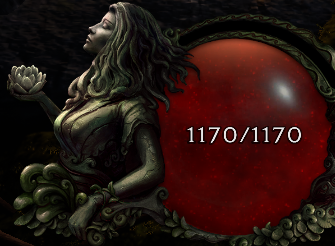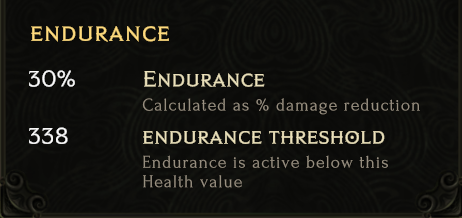Defenses for Beginners in Last Epoch
Last Updated:October 13, 2024|Changelog
In the Defense guide for beginners we cover the basics you need to know about key Defenses like Resistances, Armor, Endurance, Sustain and much more! Having solid Defenses is crucial to your success in Last Epoch. Learn how to scale your Defenses with this guide and cruise through any challenge without worry!
This is a beginner's guide. For a more thorough explanation, check out our Defenses Explained Guide.
Hit Points (HP)
When your Hit Points are reduced to zero, you die. HP is the most basic Defense, and it is effective against all Damage meaning there is no sources of Damage that can negate it or make it less valuable, so stacking HP is generally a good strategy.

- Added Health will always be a flat amount (never a percentage). Multiple sources of Added Health are added together. You'll find sources of Added Health on gear, in passives, and you'll get a small amount every time you level. Each point of the attribute Vitality also provides 6 HP. E.g. if you have 100 Added Health, and you acquire an item with 50 Added Health, you now have 150 Added Health.
- Increased Health is a multiplier of your Added Health. You can find sources of Increased Health on gear and in passives. E.g. if you have 150 Added Health, with 50% Increased Health, then you have 150 * (1 + 0.5) for a total of 225 HP.
- Hybrid Health is found solely through the Hybrid Health Shard, which provides both Added and Increased Health. It can only be found on or applied to Gloves, Boots, and Belts.
Ward
Ward is very similar to HP, as it increases the amount of Damage you can take before your character dies. Any Damage you take is taken from your Ward before your HP.

- Unlike Energy Shield in Path of Exile, nothing can surpass Ward and damage your HP directly. The only exception to this rule currently are effects that deal X% Damage to current Health. The most obvious example of this is the blood pools in the Emperor of Corpses boss fight.
- You can generate Ward through multiple sources, e.g. Ward Per Second, Ward on Hit, Ward on Use, Ward on Kill.
- Ward decays over time. The more Ward you have, the faster your Ward decays. This puts a limit on how much Ward you can accumulate at any given time. It is possible to slow Ward decay through Ward Retention. This stat can be found on Passives, Gear, Skills. Intelligence also grants 4% Ward Retention per point.
Sustain
Sustain includes any mechanics that replenish HP after Damage has been taken.
- Leech takes a percentage of Damage dealt by the player and returns it as Health. For example, you have 5% Leech and you do 100 Damage to an enemy. Your Leech amount is: 100 * 0.05 = 5.
- The amount of Leech a player receives is not instant. Instead, it is restored over a 3 second period.
- Leech is a very strong source of Sustain, especially with high Damage and/or a high percentage of Leech. There are sources of Leech for all damage types, including DoTs. Keep in mind that not all sources of Leech work for all Damage types.
- You can increase your Leech Rate from sources like Grand Thirst of the Sun. Note that this does not actually increase the overall amount of Leech you receive, it just shortens the 3 second timer on Leech, giving you the full amount faster.
- Overkill Damage (when your Damage is higher than the enemy's HP) does not count for Leech purposes unless you're using an item like Woven Flesh, which specifically provides Overkill Damage Leeched as Health.
- Health Regeneration grants a flat amount of HP per second. All characters start with 6 Base Regen, which will gradually increase as you level up. Regen can be further scaled with Added Health Regeneration and Increased Health Regeneration. Added Regen is a flat amount, with all sources being added to your Base Regen and then multiplied by the total amount of % Increased Regen you have. E.g. if you have 6 Base Regen, 10 Added Health Regen and 20% Increased Health regen, your total Health Regen is: (6 + 10) * 1.2 = 19.2.
- Healing is generally provided by Skills, Subskills or procs, and it will restore a certain amount of HP to the player. The Health can be restored instantly or over time. Healing can be scaled through Healing Effectiveness. All sources of Healing Effectiveness are added together, and then multiplied against the Base Healing amount.
- Examples of Healing and Healing Effectiveness sources: Holy Trail, Holy Symbol, Valor.
- Health on Action can best be described as "When you do X, you gain Health". These Actions are often mechanically similar to Healing, but are not considered Heals and are therefore not scaled with Healing Effectiveness. Some examples of these are:
- For Rogue: Draining Arrows and Perfect Aim can be used as the primary sustain of Marksman builds.
- For Sentinel: Time and Faith provides Health on Skill use.
- Generic sources: Health On Melee Hit and Health On Kill affixes.
Resistances
Resistances are one of the most basic kind of Defense. They provide protection against the damage type that corresponds with the Resistance. All Resistances cap at 75%, and there is no way to increase the cap. Any Resistance over the cap does not provide any mitigation, but it can help to prevent Resistance Shred and Shock from reducing your Resistances to below the cap.

- The full list of Resistances are:
- Fire, Lightning, Cold. Also known as Elemental Resistance.
- Physical, Poison, Necrotic, Void.
- Resistances protect against both Hits and DoTs, including Damaging Ailments.
- As a general rule of thumb, we recommend getting your Resistances capped by early-mid Monolith. Before that, focus on the Resistance(s) that protect against the most common Damage types in the content you are doing. For example, chapter 1 is Void and Physical, while Chapter 9 is largely Poison.
- Resistances can be reduced to negative values, with each 1% of negative Resistance increasing Damage taken of that type by 1%.
- Capping your Resistances is important, but having Resistances below the cap is less punishing than in Path of Exile.
Armor
Armor provides Damage mitigation against Hits, but it has no effect against Damage over Time.
- Armor provides more Damage mitigation for Physical Damage than other Damage Types, capping at 85% for Physical and 59.5% for all other Damage Types.
- The percentage of Damage mitigated by Armor depends on your Armor value and the level of the area. You can see your Physical Damage mitigation from Armor for your current area level in the Character sheet. Hovering over it will also display your mitigation for other Damage Types.
Dodge
Dodge is a defensive mechanic that grants you a chance to completely avoid a Hit, negating any Damage it would do and any Ailments it would apply. DoTs cannot be Dodged.
- Dodge chance has a cap of 85%.
- Dodge chance is calculated based on your Dodge Rating and the level of the area. You can see your chance to Dodge for your current area level in the Character sheet.
Endurance
Endurance is a unique defensive layer that allows you to take less Damage while below a certain Health value. While your Health is less than your Endurance Threshold, you will take less Damage equal to your Endurance value. This reduction applies to Health, but does not apply to Ward.

- Endurance increases the amount of Damage Reduction a player will receive, up to a maximum of 60% less Damage taken. It has a baseline of 20%.
- Endurance Threshold is the amount your HP must be below of in order to receive Damage Reduction from Endurance. It has a baseline of 20% of the player's total HP, which means this number will scale with increases to HP along with increases to the stat itself.
- Endurance applies to any Damage taken below your Endurance Threshold, even if you took the Damage while you were above it. For example, if you take a Hit of 100 Damage, but 50 of that Damage was below your Endurance Threshold, the last 50 Damage will have Endurance applied to it.
Block
Block grants a chance to reduce a portion of Damage taken from Hits. You can block all Hits including Spells, but not Damage over Time effects.
- Block Chance is rolled to determine if you block the Hit.
- Any increases to it are additive, e.g. if you have 30% Block Chance and add a source of 10% Block Chance, you now have 40% Block Chance.
- Block Effectiveness determines the amount of Damage Reduction you receive from a Block.
- The Damage Reduction from Block Effectiveness caps at 85%. The percentage of Damage mitigated depends on your Block Effectiveness value and the level of the area. You can see your Damage Reduction from Block Effectiveness for your current area level in the Character sheet.
- The Damage received from blocked Hits can be further reduced with the Reduced Damage Taken on Block affix.
Critical Strike Avoidance
Critical Strikes from enemies deal double Damage. Critical Strike Avoidance grants a chance to cause Critical Strikes to become normal Hits instead.
- Critical Strike Avoidance caps at 100%, meaning you can never be Crit. Capping this stat as soon as possible is highly recommended, especially on Hardcore!
- Using Woven Flesh early on provides an efficient way to cap Crit Avoidance. This item has a 50% chance to drop from the Abomination in the Fall of the Outcasts Timeline
- One of the best sources of Crit Avoidance is the Grand Survival of Might Blessing. You can also get it from multiple gear slots thanks to the Critical Strike Avoidance affix.
- Reduced Bonus Damage Taken from Critical Strikes is an alternative to Crit Avoidance. It reduces the amount of extra Damage taken from a Crit. With 100% of this stat, Crits will be fully reduced to regular Hits.
- This stat is found on Helmets, Body Armors, Boots, Gloves, Belts and Shields. In addition, it can be acquired from Two-Handed Axes, Maces, Spears and Swords.
Summary
- Health is your most vital stat. Reach 0 and you're dead.
- You'll need sources of Added and Increased Health to properly scale your Health.
- Ward works like additional Health but it decays over time and Damage is taken from Ward before Health.
- Having good Sustain is important for staying alive and to fully take advantage of your Health Pool.
- Resistances are very important. You'll want to cap them, but it isn't quite as necessary as some other games like Path of Exile.
- Capping either Critical Strike Avoidance or Reduced Bonus Damage Taken from Critical Strikes is highly recommended.
- The other major defensive layers are: Armor, Dodge, Endurance and Block.
For more advanced Defensive mechanics like Glancing Blow, Stun Avoidance and Debuffs, check out our Defenses Explained Guide.
Credits
Written by Volca.
Reviewed by McFluffin.